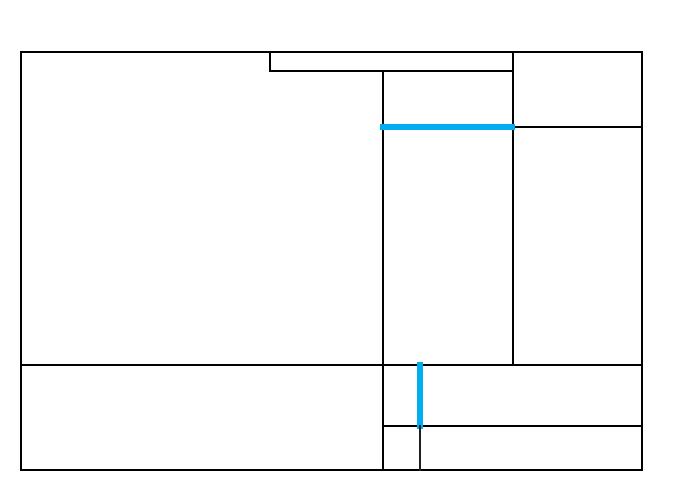
4 minute read
1.3.2 Summarizing work-flow using stepwise procedure into set of rules
1.2.2 Summarizing work-flow using stepwise procedure into set of rules.
In figure 1-7 the pseudocode(f) rightly demonstrates the importance of setting clear design intent for deciding the hierarchy of steps required to flow through data that may help achieve a desired outcome. This decision making process here becomes of paramount importance as the previous step influence the next step.
Advertisement
Here the student defines constrains of vertical division, quantity of red & location while uses the horizontal division, proportions of red, These initial steps established through parameter, constrain and rules would have a direct relationship on the behavior of remaining steps in the pseudocode(d) .
Setting up domains for your parameter places such a system at the forefront of probabilistic design where the result adhere to the designers initial intent supported a strong logic.
Pseudocode(f) is a non programming language used to outline a rough draft of script syntax in simple words by establishing procedure of various rules, parameters and constraints. It summarizes a program flow, but excludes underlining details.
Figure 1-7 Pseudocode illustrations(Astha Shah final year B.Arch)











Pseudocode
STEP 01: DEFINE A PRECINCT
Defining a rectangle with original proportions i.e. 3:2. Calculate area of the rectangle. Calculate area of red rectangle i.e. 30% of total area. Constraint : The proportion of the precinct.
STEP 02: DEFINE THE CONTROL LINE TO CREATE TWO STORIES
Divide the rectangle as per the original proportions i.e. 7:5, by a vertical line into two stories: The story of Simplicity & The story of Chaos Constraint: The position of the control line.
STEP 03: DEFINE THE STORY CONNECTOR
Add a horizontal line that connects both the stories together and creates the room of red, black and yellow. Parameter: Position of story connector varies In Y-axis from 10% to 40% length of the shorter Axis of the sector.
STEP 04: DEFINE THE DOMINANT RED
Create the red rectangle of the fixed area (calculated in step 02) by adding a vertical line in the room of red. Change this line with respect to the story connector keeping area of red constant. Parameter: Position of the line varies in X-axis. Constraint: Area of the dominant red.
STEP 05:

STEP 01

STEP 03 STEP 02


STEP 04
DEFINE THE FIRST BLACK COUSIN
Create the black rectangle by adding a vertical line in the room of black. Parameter: Position of line varies in X-axis Maximum area: 15% of area of red.
STEP 06: CREATE THE ROOM OF YELLOW & BLUE
Calculate the area of room of yellow rectangle. Create a vertical line that divides the larger void of the chaotic story into two non-equal parts. Parameter: The area of room of blue is always greater than area of room of yellow.
STEP 07: DEFINE THE BLUE TWIN
Create the blue rectangle of the fixed area by adding a horizontal line in the room of blue. Parameter: Position of the line varies in Y-axis. Constraint: Area of the blue twin.
STEP 08: DIVIDE THE ROOM OF YELLOW
Create a subdivision in the room of yellow by adding a horizontal line. The areas of yellow rectangle and blue rectangles are equal. Thus, they are called twins.

STEP 05

STEP 07 STEP 06


STEP 08
STEP 09: DEFINE THE YELLOW TWIN
Create the yellow twin of fixed area by adding a vertical line. The rectangle formed as a by-product is the second black cousin. Parameter: Position of the line varies in X -axis. Constraint: Area of the yellow twin equal to Area of blue twin.
STEP 10: DEFINE THE COMMON SUBDIVISION (IF TRUE)
Create a subdivision which is a part of both the stories by adding a horizontal line. Position of line at original proportions. Constraint: Position of horizontal line Creating the common subdivision, if present.
STEP 11: TRIM THE CONTROL LINE (IF TRUE)
Trim the control line from the common subdivision. Thus, making the common subdivision as one element present in both the stories simultaneously.
STEP 12: INTENSIFYING THE CHAOS (IF TRUE)
Add horizontal and vertical lines in the story of chaos to intensify. Make subdivisions by adding terminating lines in the voids.
Rule: Paint one rectangle black with addition of every four lines. Rule: number of horizontal lines added = number of vertical lines added.

STEP 09 STEP 10


STEP 11 STEP 12











